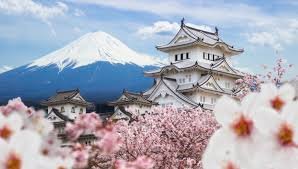
japan travel guide japan travel guide
Introduction to Traveling in Japan
Japan is one of the world’s most fascinating travel destinations, offering an extraordinary blend of ancient tradition and cutting-edge modernity. From tranquil temples and historic castles to futuristic skyscrapers and high-speed trains, the country captivates every type of traveler. Its islands stretch across diverse climates and landscapes, ensuring that visitors experience everything from snowy mountains and hot springs to subtropical beaches and vibrant urban life.
A Japan travel guide must go beyond basic sightseeing to capture the nation’s unique rhythm of life. With rich culture, world-renowned cuisine, and a deep respect for both history and innovation, Japan provides travelers with experiences that remain unforgettable long after their journey ends.
Why Visit Japan
Traveling to Japan offers countless rewards. The country’s safety, cleanliness, and efficiency make it welcoming for first-time visitors. Highlights include:
- Cultural immersion: Ancient shrines, geisha traditions, sumo wrestling, and tea ceremonies.
- Modern wonders: Tokyo’s neon districts, bullet trains, and innovative technology.
- Natural beauty: Cherry blossoms in spring, colorful foliage in autumn, and dramatic mountain ranges.
- Culinary excellence: Sushi, ramen, wagyu beef, and countless regional specialties.
This combination of contrasts—old and new, quiet and bustling, traditional and futuristic—defines Japan’s unique appeal.
Best Time to Visit Japan
Japan can be visited year-round, but each season offers something special.
- Spring (March–May): Famous for cherry blossoms, mild temperatures, and colorful festivals.
- Summer (June–August): Warm weather, lively matsuri (festivals), and opportunities for hiking or island escapes.
- Autumn (September–November): Stunning foliage, comfortable climate, and harvest celebrations.
- Winter (December–February): Skiing in Hokkaido, snow festivals, and relaxing in onsen (hot springs).
Choosing the right time depends on personal preferences, but many travelers aim for spring or autumn for ideal weather and breathtaking scenery.
Top Destinations in Japan
Tokyo
Japan’s bustling capital combines tradition with innovation. Visitors explore historic temples like Senso-ji, vibrant shopping districts such as Shibuya and Shinjuku, and cutting-edge attractions like the Tokyo Skytree. Tokyo also serves as a hub for day trips to places like Nikko and Yokohama.
Kyoto
Known as the cultural heart of Japan, Kyoto is home to over 1,600 temples and shrines. Highlights include the Golden Pavilion (Kinkaku-ji), Fushimi Inari Shrine, and seasonal delights like cherry blossoms in Maruyama Park. Traditional tea houses and geisha performances add authenticity to the experience.
Osaka
Famous for its street food and friendly atmosphere, Osaka delights visitors with takoyaki, okonomiyaki, and bustling nightlife. Attractions include Osaka Castle, Universal Studios Japan, and the lively Dotonbori district.
Hokkaido
Northern Japan’s Hokkaido region offers world-class skiing, hot springs, and natural landscapes. The annual Sapporo Snow Festival attracts visitors worldwide, while summer showcases wildflower fields and outdoor adventures.
Okinawa
For tropical beauty, Okinawa’s islands boast white sand beaches, coral reefs, and a unique culture influenced by its Ryukyu heritage. It’s an ideal destination for snorkeling, diving, and relaxation.
Japanese Food Culture
Japan’s culinary scene is a highlight of any visit. From Michelin-starred restaurants to local izakayas, the variety is endless. Travelers should try:
- Sushi and sashimi at traditional counters.
- Ramen variations from different regions.
- Tempura made with fresh seasonal ingredients.
- Kaiseki dining, a multi-course haute cuisine experience.
- Street foods like taiyaki, yakitori, and melon pan.
Japanese food culture emphasizes seasonality, presentation, and balance, making every meal a cultural experience.
Transportation in Japan
One of the most remarkable aspects of traveling in Japan is its efficient transportation system.
- Shinkansen (bullet trains): High-speed, comfortable, and punctual, connecting major cities quickly.
- Subways and buses: Extensive networks make urban travel easy.
- Japan Rail Pass: A cost-effective way for visitors to explore multiple regions.
- Bicycles: Popular for exploring smaller cities and countryside areas.
Navigating Japan may seem daunting at first, but the country’s clear signage, helpful locals, and mobile apps make it straightforward.
Cultural Etiquette for Travelers
Respecting Japanese customs ensures a smoother travel experience. Some key etiquette tips include:
- Bowing as a greeting or sign of respect.
- Removing shoes before entering homes and certain traditional spaces.
- Quietness on trains, where phone calls are discouraged.
- Politeness in communication, with phrases like “arigatou gozaimasu” (thank you) used often.
- Proper chopstick use, avoiding gestures considered impolite.
These practices reflect Japan’s emphasis on harmony and respect, and visitors are warmly received when they show awareness of them.
Unique Experiences in Japan
Beyond the famous landmarks, Japan offers countless unique experiences:
- Staying in a ryokan (traditional inn) with tatami floors and futon bedding.
- Bathing in natural onsen hot springs.
- Watching a sumo wrestling tournament.
- Participating in a tea ceremony or kimono rental experience.
- Exploring traditional craft villages for pottery, textiles, or woodworking.
Such experiences provide deeper connections to Japan’s culture and heritage.
Shopping in Japan
Shopping is another highlight, offering everything from luxury brands to quirky souvenirs. Popular items include Japanese cosmetics, electronics, traditional crafts, and green tea. Cities like Tokyo and Osaka feature massive shopping districts, while smaller towns offer charming local markets. Duty-free shopping and Japan’s high-quality standards make purchases reliable and memorable.
Safety and Travel Tips
Japan is one of the safest countries in the world, but travelers should still take precautions. Always carry cash (as some establishments do not accept cards), learn basic Japanese phrases, and familiarize yourself with local transportation apps. Staying connected with pocket Wi-Fi or SIM cards also helps with navigation and communication.
For updated safety advice and travel planning, resources like Japan Guide provide reliable, comprehensive information.
Accommodation Options
Japan offers a wide range of accommodations to fit any budget:
- Luxury hotels in major cities.
- Ryokan inns offering traditional experiences.
- Business hotels for convenience and affordability.
- Hostels and guesthouses for budget travelers.
- Capsule hotels for a uniquely Japanese stay.
Each option reflects different aspects of Japanese hospitality, from efficiency to cultural immersion.
The Future of Tourism in Japan
As Japan prepares for future growth in tourism, the focus is on sustainability, technology, and regional development. Efforts are being made to balance international interest with preservation of cultural heritage. Smart technologies like AI-driven translation and cashless payments continue to enhance convenience for foreign visitors.
The growing emphasis on eco-tourism and lesser-known destinations encourages travelers to explore beyond Tokyo and Kyoto, spreading economic benefits across the country.
Conclusion
A Japan travel guide reveals much more than a list of attractions—it highlights a nation where ancient traditions and futuristic innovations exist side by side. Whether marveling at cherry blossoms, tasting regional delicacies, relaxing in an onsen, or exploring neon-lit streets, Japan offers experiences that inspire and transform.
Every traveler leaves with more than memories—they carry a deeper appreciation for a culture rooted in respect, artistry, and progress. For anyone seeking a destination that is endlessly fascinating, Japan is a journey worth taking.






